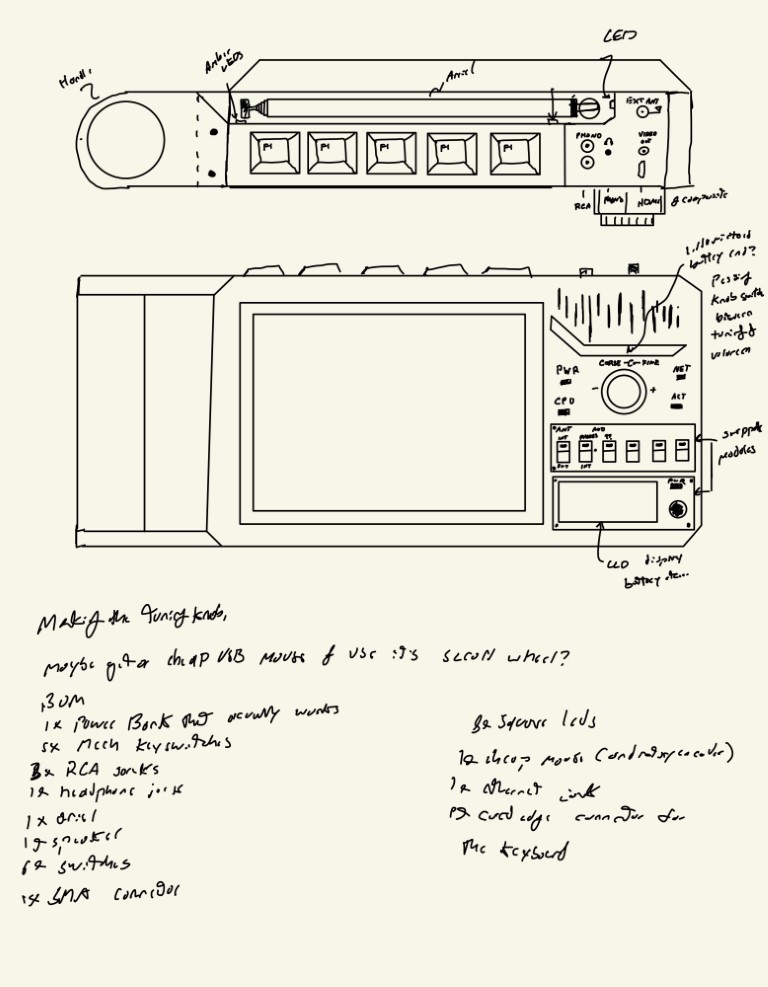Cyberdeck Zero 000-PCS-2R3C2400L-A
Background
Radio is a long fascination of mine. As a child I would stay up late into the night, listening to strange sounds on the AM band, until scared me enough that I would turn it off. My relationship with radio has changed over time, and remains a strong interest. A few years ago, I decided to look into Software Defined Radio, SDR. A short definition is that SDR is just a radio connected to a computer; it takes advantage of that to blow the capability of radio reception wide open. Typically when paired with software, the SDR will allow you to "see" radio signals, represented on what's called the waterfall. The stronger the signal, the brighter and more "hot" it appears on the waterfall. This is fascinating to me, taking the medium of radio signals, and making them something visual instead of just audible. You aren't restricted to AM or FM or maybe some weather bands either, you can pick up anything if it makes radio waves, you'll see it.(sometimes this is a detriment as everything electrical makes radio waves)
For some time now, I can really only use my SDR receivers on my laptop, which is fine and it does work, however, I wanted something more radio-like. About 2 years ago when I started getting into this, I also read Neuromancer for the first time. This eventually led me to a community of hackers, artists, and nerds like myself that build devices called cyberdecks, akin to the ones used to enter cyberspace in the novel. These decks can take on many forms, from old TVs and computers given new life to just a tangle of wires and lights in a cardboard box. This one on Hackaday was a huge inspiration for me, just in terms of function. I started planning to build my own.
Initially, I was planning to just build mine into a pelican case, but I quickly decided this wasn't me at all. Cyberdecks are just as much an art piece as they are a computer, and thus an expression of the creator and user. The pelican case was far to much "United States Military equipment" and not "trans nb punk's tool to access radio waves"; but I've got a 3D printer, so I can make it whatever I wanted.
Design
There were a few design influences that I pulled from. Namely this weather radio I had, and also the "look" of oscilloscopes, however I also pulled a lot from what I imagined the cyberdecks from Neuromancer and it's inspirations would look like if common in our world. I imagined a world-line where the drive for ever smaller portable devices was reduced, and was populated with computers like this, rather than the sleek, impossible-to-repair, fragile slabs that occupy our pockets. A alternate time where instead of going from luggable to laptop, we went from luggable to slightly less heavy luggable.
I wanted my design to be the antithesis of so much of the consumer tech that dominates our lives. At one point I wanted to make the whole thing out of garbage I pulled out of the dumpster (I may come back to that idea). Big tech companies continue to pump out shiny, unfixable, fragile slabs, and continue to push for "less connections and I/O, less battery, less is more!". (I still remember the days when buying a new battery for a phone was not a big ordeal). My design would stand in opposition to this design, it would have heaps of I/O, namely: USB, HDMI video, composite video, audio out, antenna connections, and ethernet, with potential for more in the future. Its battery would not only be replaceable, it would be hot-swappable, you can just pull it right out of the side. It would have a handle for lugging, and a strap for toting. I wanted it to be something that didn't fit in with the design language we are so familiar with.
One of my favorite ideas I've worked into its design is the tuning dial. Radios have almost from the very beginning had a tuning dial of some sort. In the days before digital it was attached to a adjustable capacitor, allowing for picking up specific frequencies. I would need something - a little less analog for my purposes. SDR software almost always uses the scroll wheel of the mouse to tune like you would on an old radio. This gave me an idea, the mouse's scroll wheel is just a rotary encoder, which I could swap for one of a different style. So I purchased a cheap USB mouse and used it's little microprocessor to build a module with my new encoder so it functioned just like a radio dial. I even added the mouse's click back in, although I don't have a use for that yet, maybe I can make it a macro to save frequencies or to record audio or something.
Future Plans
I've had a lot of other ideas while working on this project, it's part of what makes it difficult to finish. Scope creep has tried to force its way in quite a few times. I've decided that this deck will just be for radio, and that I can either modify it, or build another in the future to include these other ideas. Here's what I'd like to add:
- A custom "dock" that the deck snaps into, which could include a mechanical keyboard, trackball, extra battery, or other features
- MIDI support, possibly with a custom "dock" including a MIDI keyboard and synth, along with better speakers
- A GSM module to allow it to make phone calls (with the benefit of maybe using that giant antenna)
- Switching out the RTL-SDRs for different receivers
Gallery
 |
 |
 |
 |
 |
 |
 |
 |